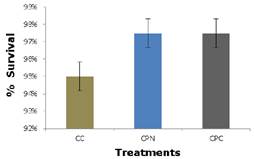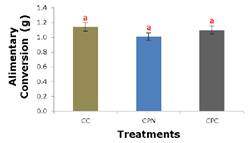INTRODUCCIÓN
The fish (Hypostomus plecostomus), commonly known as “Panche” dwells in shallow freshwaters, and it is part of the indigenous fauna of fish in the department of Norte de Santander and the country. It belongs to the most important catfish family (Loricariidae family) in Colombia regarding the amount of known forms. They are vegetarian or detritophague due to the size of their intestines and their buccal adaptations which are especially designed for the suction of phytoplankton, detritus and small crustaceans, which they mainly obtain from the surface of rocks and submerged plants. They are monogastric fish and the micro flora present in their digestive system is unknown, since up to date there is not a written record which demonstrates the different microbial species existent in the gastrointestinal tract of these animal species.
In the last few years there have been significant advances regarding the production of a wide range of aquatic organisms. One of the most successful freshwater species in aquaculture is tilapia (Oreochromis sp). These species, at commercial standards, are grown in intensive and semi intensive systems, where the nourishment requirements are met through complete artificial diets. Because of the growth conditions, such as high sowing density and limited amount of water, the organisms are subjected to a constant stress that is translated to low growth rates and alimentary efficiency, as well as the presence of opportunistic disease. In order to avoid these problems, studies have been directed to identify new additions such as the microorganisms called probiotics, which represent an option in order to improve the health and growth of the organisms, resulting on a greater production. The knowledge of the use of probiotics can substitute of antibiotic therapy as a less aggressive method, and it has resulted in a new vision in livestock industry, when considering a global technology from the isolation of probiotics of specific ecosystems, for instance the microbial flora indigenous to the species or geographic region of interest, the selection and characterization of the bacteria responsible of the probiotic action, their industrial production, process and reintroduction to the diet of the animal.
The use of probiotic in feeds to improve growth of different fish species including African catfish (Clarias gariepinus) 1; Senegalese sole (Solea senegalensis) 2; Nile tilapia (Oreochromis niloticus) 3,4; Japanese flounder (Paralichthys olivaceus) 5; gilthead sea bream (Sparus aurata) and sea bass (Dicentrarchus labrax) 6 has been investigated. The effects of probiotics have been linked to modulation of gut microbiota and establishment of the beneficial microorganisms, higher specific and total digestive enzyme activities, in the brush border membrane, which increases the nutrient digestibility and feed utilization 7,8.
The isolation and characterization of probiotic microorganisms can constitute an alternative for aquaculture feeding, which is going to be reflected on the health of the host animal, in this case, red tilapia (Oreochromis sp.), as well as a significant reduction in the use of antibiotic therapy, the improvement in the assimilation of nutrients and substantial increase in weight gain and growth 9. The assessment of the application of probiotic microorganisms in the aquaculture industry gives the department of Norte de Santander a choice to improve the quality and innocuousness of the fish raised in the fish farm stations.
Along with the development of this work, it is also sought to strengthen the educational and scientific knowledge, for the information of these new nourishment alternatives with cultivable bacteria present in the samples object of this study. Nevertheless, since this practice is still recent in aquaculture, the microorganism species used are few, which is why strains with probiotic characteristics are still being selected which are preferably found in the digestive tract, liver, kidney, gills and skin of the fish. This means that it is important for future researchers to deepen in this kind of studies to generate new knowledge and alternatives in both aquaculture and livestock production 7. The aim of this study was to assess the behavior of red tilapia juveniles (Oreochromis sp.) in presence of the possible probiotic microorganisms isolated from the gastrointestinal tract of panche fish (Hypostomus plecostomus).
MATERIALS AND METHODS
Obtaining probiotics. The three strains of Lactobacillus genus (Lactobacillus plantarum, Lactobacillus pentosus, Lactobacillus rhamnosus) chosen to make up the probiotic, were isolated from a section of the intestines of Panche fish Hypostomus plecostomus, which was homogenized in 10 ml of Thioglycollate Broth. Dilutions of (10-3) were done and 0.1 ml were inoculated in MSR agar plates (Merck), by duplicate. The plates were incubated at 37°C during 24 hours in aerobic and anaerobic conditions. After the incubation period the count of colony forming units was done for each dilution (CFU/ml) and through successive recultivations, the strains were purified and characterized microbiologically and molecularly 10. The probiotic capacity of the strains was determined by four techniques: resistance to acid pH, resistance to bile salts, pathogen inhibition against pathogens as Pseudomonas sp, Sthapylococcus sp, Salmonella sp and Escherichia coli and resistance to antibiotics 11.
Formulation of native probiotics. The indigenous probiotic was made up by three strains of Lactobacillus and compared to the commercial probiotic L. rhamnosus (Elmor). The inoculum of native isolates was prepared having an axenic fresh culture of the three isolates that were selected for the conformation of the native probiotic, cultivated in MRS agar (Merck) at 37°C for 48 hours, inoculated in 5 ml of MRS broth (Merck) at 37°C between 8-10 hours, obtaining a suspension in the OD range of 0.10 - 0.130 equivalent to 1-2 x 108 CFU/mL 11. After the adjustment of the three probiotic agents, 1 mL of each probiotic was inoculated into 12 mL of MRS broth, to obtain a stock solution of the native probiotic.
Probiotics in relation to quantity of feed in (g) supplied. The probiotic solution for both native and commercial was prepared to a relation 5: 2 Water-Molasses, a relation of five liters of water plus two liters of molasses for a bag of food (Italcol) of 40 kg, and this relation was taken for 1 kg, placing 125 mL of water, 50 mL of molasses and 100 mL of probiotic 12,13. This water-molasses-probiotic feed with the concentrate was homogenized and fractionated in rations to feed the fish six times a day.
Production of diets. Three experimental treatments were formulated taking into account the nourishment needs of red tilapia (Oreochromis sp.). All the treatments were made with the same commercial concentrate feed (Table 1).
Table 1 Composition of the commercial concentrate feed in the nourishment of Oreochromis sp.
| Content | % | |
| Minimum protein | 40 | |
| Minimum grease | 6 | |
| Maximum fiber | 6 | |
| Maximum humidity | 12 | |
| Maximum ashes | 12 | |
| Source. Italcol S.A |
Treatment 1 CC (Control Concentrate): Concentrate feed without the addition of the probiotic.
Treatment 2 CNP (Concentrate plus Native Probiotic): Concentrate feed plus the native probiotic extracted from the Panche fish (Hypostomus plecostomus) in a concentration of 108 CFU.
Treatment 3 CCP (Concentrate plus Commercial Probiotic): Concentrate feed plus the commercial probiotic made up by Lactobacillus rhamnosus adjusted to a concentration of 108 CFU.
Bioessay. 12 aquariums made of 5mm thick glass with dimensions of 45 cm height, 48 cm width and 65.35 cm length and a total capacity of 140.42 liters were used. The aquariums were kept with a volume of 110.31 liters of water, 11.031 liters per fish, a pH of 8.09±0.13 and a temperature of 28.99±1.05°C. These conditions were maintained throughout the experiment; the aquariums were cleaned from food remains and feces daily. In a random way 10 juvenile organisms of Oreochromis sp were introduced into each aquarium. With average values of 1.28±0.22 g weight; 2.1±0.28 cm length. The organisms were weighed in an analytical balance (Mettler PM 460 DeltaRange®; Mettler Instrument Corp., Highstown, NJ, USA) and their total length was measured with a vernier. The fish were fed six times a day (6:30, 8:30, 10:30, 12:30, 14:30 y 16:30 hours), according to the 8% of their biomass. The experiment had a duration of 30 days.
Statistical analysis. The statistical model employed was a completely random design. For the data analysis, the statistical software InfoStat version 2014 was used. The variance analysis was done to determine the existence of significant differences among treatments, with a significance level with α= 0.05. The Duncan test was used to make the multiple comparisons among the media.
Furthermore, the data obtained regarding food consumption, biometries, initial-final weight, initial-final length and environmental conditions were noted and digitalized through the use of the program Microsoft Excel® 2010 (Microsoft Corp., Washington, EU). Thus the data were processed through descriptive statistics and expressed in averages ± standard deviation.
The variables analyzed in the experiment on red tilapia (Oreochromis sp) juveniles were the following:
Weight gain (WG) = [Final weight (g)-Initial weight (g)]
Length gain (LG) = [Final length (cm)-Initial length (cm)]
Alimentary conversion (AC) = (Serving consumption (g))/(Weight gain (g))
Alimentary efficiency (AE) = (Weight gain (g))/(food consumption (g)) × 1000
Specific Growth Rate (SGR)=(ln final weight - ln initial weight/(# feeding days))100
Proteic efficiency rate (PER) = ((Weight gain (g))/(Gross protein consumed (g)))
Survival (S) = 100 - [((Initial number of fish - Final number of fish )/(Initial number of fish))*100]
% of incidence = (# of diseased fish)/(# of healthy fish) x 100
RESULTS
Length (L). The organisms fed with the diet enriched with CNP got the greatest length gain (4.16±0.770 cm), while the lowest value was obtained with the CC diet (3.76±0.948 cm) (Figure 1). The analysis pointed out that the CC y CCP diets did not show significant differences (p>0.05) between each other. CC and CNP diets showed significant differences between each other (Table 2).
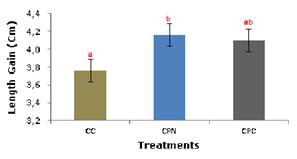
Figure 1 Length gain in Oreochromis sp regarding Control Concentrate (CC), Concentrate plus Native Probiotic (CNP) and Concentrate plus Commercial Probiotic (CCP) at 30 days of culture.
Table 2 Indexes of productive yielding observed during the growth of red tilapia (Oreochromis sp.) juveniles comparing control concentrate (CC), concentrate plus native probiotic (CNP) and concentrate plus commercial probiotic (CCP) at 30 days of culture.
| Productive Indexes | CC | CNP (1X10-8 CFU) | CCP (1X10-8 CFU) |
|---|---|---|---|
| Weight Gain (g) | 6.51±2.330a | 7.22±2.780a | 6.46±2.130a |
| Length Gain(cm) | 3.76±0.948a | 4.16±0.770b | 4.10±0.630ab |
| Initial weight (g) | 1.28±0.220 | 1.28±0.220 | 1.28±0.220 |
| Final weight (g) | 7.79±2.330a | 8.5±2.780a | 7.74±2.130a |
| Alimentary Conversion (g) | 1.14±0.910a | 1.01±0.620a | 1.10±0.750a |
| Alimentary Efficiency (g) | 1112.71±399.25a | 1230.83±473.92a | 1099.51±363.06a |
| Specific Growth Rate (%/day) | 199.04±35.65 a | 206.98±37.74a | 199.35±32.32a |
| Proteic Efficiency Rate (g) | 2.78±1.25a | 3.08±1.18a | 2.75±0.91a |
| % Survival | 95.00 | 97.50 | 97.50 |
| % Disease Incidence | 5.26 | 2.56 | 2.56 |
| Equal letters in lines point at the lack of significant difference (p<0.05) between the diets. Average values (± standard deviation). CFU: Colony Forming Units |
Specific growth rate (SGR). CNP diet presents the highest value (206.98 %/day), followed by CCP with 199.35 %/day; and CC only got an increase of 199.04 %/day. (Table 2, Figure 2)
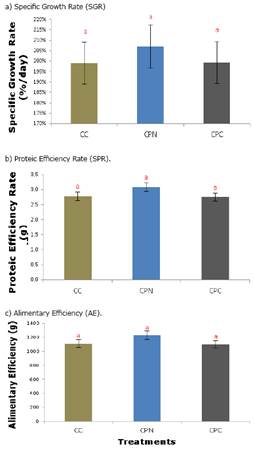
Figure 2 a) Specific growth rate (SGR) Values, b) Proteic efficiency rate (SPR) and c) Alimentary efficiency (AE) in relation to the weight of the organisms fed with the three treatments CC, CNP and CCP at 30 days of culture.
Proteic efficiency rate (PER). CC and CCP diets obtain the lowest values (2.78 and 2.75 g, respectively), with CNP obtaining the highest rate of 3.08 g. (Table 2, Figure 2).
Alimentary efficiency (AE). This was the highest with CNP diet (1230.83 g) and the lowest with CCP (1099.51 g). (Table 2, Figure 2).
Weight (W). On table 2 the average values of gain weight and final weight of the organisms fed with the three diets are presented, as well as the results of their statistical analysis. The organisms fed with the diet enriched with CNP are the ones that got the greatest weight (8.5±2.780 g), while the ones with the lowest values are those fed with the CCP diet (7.74±2.130 g).
The statistical analysis indicates that at the end of the experiment (30 days), the CNP and CCP did not present significant differences between each other, just as the CC and CNP diets. The best weight gain was with the CNP diet (7.22±2.780 g) and the lowest was with CCP (6.46±2.130 g) (Figure 3).
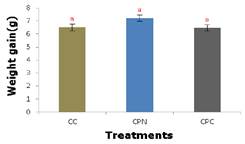
Figure 3 Weight gain in Oreochromis sp regarding the treatments with CC, CNP y CCP at 30 days from culture.
Survival (S). The organisms fed with the treatments CNP and CCP showed a better survival with a value of 97.50%, while the CC treatment recorded a value of 95% (Figure 4).
Alimentary conversion (AC). CNP treatment presented the best result of alimentary conversion with 1.01 g, while with CCP and CC the records were 1.10 g y 1.14 g, respectively (Figure 5).
DISCUSSION
It was observed that the three strains of Lactobacillus used for the native probiotic, isolated from the digestive tract of H. plecostomus, gave diverse results in the biometric variables considered, as well as in the SGR, PER, AE and AC. The best results were obtained with the CNP treatment, while CCP and CC generally gave lower values.
These variations could be caused because some Lactobacillus used as probiotics do not adhere properly to the digestive tract of some fish, due to other bacteria which may be establishing competition in the colonization of the fish’s digestive tract 14. It is mentioned that the bacteria used as probiotics actually suffer from a competitive exclusion in the digestive tract of the host, either because of food or space, which is why the inclusion of beneficial bacteria in the diet of aquatic animals can have varied effects. In this study, the fish fed with the probiotics isolated from the fish H. plecostomus, acquired a greater gain in length, which may be caused by the probiotic strains isolated from a fish, regardless their coming from another species, giving greater benefits than commercial probiotics isolated from human beings or other mammals, as in the case of L. rhamosus15.
In this investigation it was observed that by using strains with probiotic characteristics of native fish isolated Hypostomus plecostomus as a probiotic dietary supplement Tilapia Oreochromis sp have greater benefit with respect to the parameter of survival compared to Control treatment CC. Similar researches by Lara-Flores et al 3, in the cultivation and the survival time of Oreochromis niloticus, were evaluated two types of probiotics mixed in food such as S. cerevisiae and a mixture of Streptococcus faecium and Lactobacillus acidophilus, concluding that S. cerevisiae provides better performance in gaining weight, specific growth rate and better survival after nine weeks of cultivation of Nile tilapia.
Other studies also entrench the ability of the use of microorganisms as promoters of growth and survival in fish farming Hoseinifar et al 16, this research evaluated the effects of inactive brewer’s yeast (S. cerevisiae var ellipsoideus) on the growth, physiological response and gut microbiota of juvenile Beluga (Huso huso) by including it in the diet at concentrations of 1% and 2% (w/v), presenting better results in gaining weight, specific growth rate and survival after six weeks of cultivation.
Other similar work in tilapia cultivation introduced by Mello et al by 17 indicates that the use of strains of Bacillus cereus at a concentration of 4,0x108 UFCG-1 and Bacillus subtilis 4,0x108 UFCG-1 As probiotic strains in diet of juvenile Nile Tilapia, they have demonstrated a survival rate of 89.47% compared to the control fish without the addition of probiotics with a percentage of 76.61% survival, contrary to the results of the study presented by Albuquerque et al 18 by using Bacillus cereus and Bacillus subtilis var. Toyoi C-3102 as probiotic strains supplied individually or in combination in the diet of juvenile tilapia, the results had no significant difference in the growth rate parameter after 127 days cultivation.
Recent researches on the introduction of bio-preparations with probiotic characteristics in the diet for growing red tilapia Oreochromis sp proposed by Mantilla et al 19, presented similar results to those presented in this study, such as: greater productive performance and survival compared to control treatment for 45 days cultivation.
With the analysis of the results of this work, it is recommended to carry out more nourishment tests increasing the period of assessment of the given probiotic strains, since the productive variables in these kinds of experiments are better expressed after 60 days of treatment, as authors like propose the possible hypothesis that after this time the probiotic microorganisms yield a better competitive exclusion in the intestine.
In conclusion the best reports regarding length gain were for the native probiotic and it is deduced that they were easily settled in the fish intestine (Oreochromis sp.). It is determined that there are significant differences in the result of length gain for the Control Concentrate (CC) against the Concentrate plus Native Probiotic (CNP) for the red Tilapia (Oreochromis sp.) in the juvenile stage for a period of 30 days.
The percentage of disease incidence was favorable for the Concentrate plus Native Probiotic (CNP) and Concentrate plus Commercial Probiotic (CCP) since a lower number of mortality was recorded compared with the Control Concentrate (CC).
It is desirable to substitute the use of antibiotics in favor of probiotic microorganisms, since the result of their consumption would be less aggressive when compared to the effects of antibiotics. This has been one of the hints for the industries to want to research this kind of bacteria, isolating them from non-conventional samples and incorporating them to human and animal diets.













